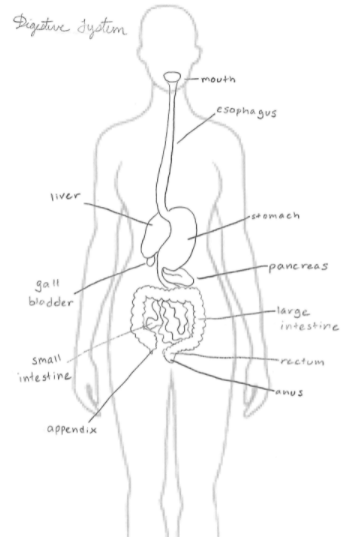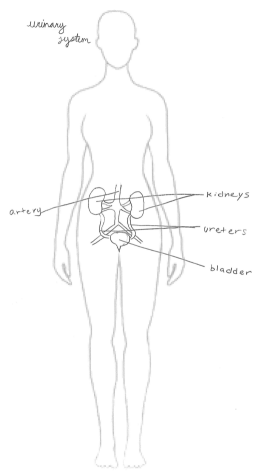the duality of disease - HSP
Welcome to my first Action Project (AP) for my STEAM class called Disease! In class, we discussed the different body systems to learn about their purpose and understand what happens when a disease manifests in different parts of the body. We also used the City Dashboard to identify statistics related to different areas across the country. These statistics were available for many metrics like health, economics, environments, and other factors that contribute to the residents’ health. In this AP, I had the opportunity to interview someone about their experience with the disease and grasp a better understanding of what it’s like to have symptoms and treatment for Henoch-Schonlein Purpura (HSP). With this information in mind, I was able to ask questions about HSP, how it impacted their life, and how they recovered.
Now, it is important to know that HSP is a pretty rare disease, and unfortunately, there is not much treatment available (since its exact causes are unknown). Although this disease was not as prevalent long-term, the short-term effects were very uncomfortable and painful for the person I interviewed. As you will see, this disease can manifest in many parts of the body and symptoms can be very different for each person experiencing HSP. The person I interviewed encountered many symptoms including dizziness, throwing up blood, “red blemishes” on the skin, and the inability to walk. This definitely took a toll on their emotional state because “there wasn’t much to do” and they were supposed to be on vacation.
As for the healing process, the majority of the time was just letting the body rest and get better on its own. The physical symptoms lasted for “about a week or two,” but caused many discouraging feelings about recovery. During the interview, I also asked about their recovery process, and they responded, “I don't exactly remember, I think they told me to wait it out, though they did give me a lot of IV’s.”
The last question I asked was in regards to anything they learned from their experience with HSP, as well as any advice for those who may be dealing with this disease. They explained, “I'd say keep yourself focused on other things, don't fixate on it, and try to regain leg strength as soon as possible. And it'll take some getting used to but the IV’s aren't too bad.” As I mentioned before, it was clearly an uncomfortable process during these two weeks. However, as in most cases of HSP, they were able to recover fairly quickly. While some patients are susceptible to getting HSP multiple times, the person I interviewed described their singular experience with the disease and did not mention any concerns with it resurfacing in the future.
HSP is not a communicable disease, but its exact causes are still not entirely clear (AAFP, 1998). HSP can manifest in different parts of the body such as “the kidneys, digestive system, and, rarely, the central nervous system,” (NORD, 2015). Some important vocabulary regarding HSP includes capillaries (small blood vessels) which become inflamed, as well as petechiae (red or purple dots) that appear on the skin (NORD, 2015).

Since HSP can impact different parts of the body, symptoms can range from fevers and loss of appetite to abnormal bleeding in the gastrointestinal tract and joint pain. On the skin, petechiae appear, but internal inflammation can also be prompted as a response from the immune system (NORD, 2015). In addition, people can experience different symptoms within a part of the body. While some may have diarrhea, others could have severe constipation (NORD, 2015). Research has indicated that HSP is related to the immune system insufficiently reacting to an infection. Whether it is a reaction from vaccines, insect bites, or even weather is unknown, as well as its prevention (AAFP, 1998). It is also possible that the etiology of HSP is “multifactorial” and not necessarily triggered by just one change (Medscape, 2021).

The main goal of the urinary system is to remove salt and impurities as liquid waste. As depicted above, it consists of the bladder, kidneys, urethra, etc. While the urinary system consists of many parts, the kidneys are usually the most affected by HSP. Many of the people diagnosed with HSP report having blood in their urine, also known as Hematuria (NIH, 2021).

The nervous system is meant to process stimuli and send signals, but the central nervous system only consists of the brain and spinal cord. It is much less common for those with HSP to experience symptoms related to the central nervous system. However, this would include seizures, visual difficulty, convulsions, and severe headaches.
It is more common for males to be affected by HSP than females, and while all age groups are susceptible, children are the most commonly infected. Research shows that HSP could be related to abnormal immune system response, and its impact is likely not specific to any locations, heritage groups, etc (NORD, 2015). The annual incidence is about 140 cases/million persons (John Hopkins). Diagnosis can be made on symptoms, but also “blood and urine tests, imaging studies, and/or a biopsy of the skin or kidney,” (NIH, 2018). In order to differentiate HSP from other forms of purpuras, doctors can look for petechiae caused by “small hemorrhages under the skin” and not “low levels of platelets,” (NORD, 2015).
Having a medical and personal perspective on a disease is extremely helpful when trying to understand how a disease can affect a person’s life. Whether it be a stranger or a loved one, diseases can appear suddenly or overtime. Before this project, I was not familiar with HSP. Even with research, it was difficult to connect with a list of symptoms. I am definitely glad that this disease isn’t an ongoing part of the interviewee's life, and that HSP is not extremely common. I hope that this was helpful for anyone curious about HSP or anyone wanting to hear a different side of symptoms and recovery.
“Henoch-Schonlein Purpura.” Genetic and Rare Diseases Information Center, U.S. Department of Health and Human Services, https://rarediseases.info.nih.gov/diseases/8204/henoch-schonlein-purpura.
“Henoch-Schönlein Purpura.” Johns Hopkins Vasculitis Center, 1 Aug. 2014, https://www.hopkinsvasculitis.org/types-vasculitis/henochschnlein-purpura/#fast%20facts.
“Henoch-Schönlein Purpura.” NORD (National Organization for Rare Disorders), 21 Oct. 2015, https://rarediseases.org/rare-diseases/henoch-schonlein-purpura/.
N.O., HSP Interview, L.M.A., 18 January 2022.
Rajendra Bhimma, MBChB. “Henoch-Schonlein Purpura (IGA Vasculitis).” Practice Essentials, Background, Pathophysiology, Medscape, 8 Dec. 2021, https://emedicine.medscape.com/article/984105-overview.“What Is Henoch-Schönlein Purpura?” American Family Physician, 1 Aug. 1998, https://www.aafp.org/afp/1998/0801/p411.html.
Now, it is important to know that HSP is a pretty rare disease, and unfortunately, there is not much treatment available (since its exact causes are unknown). Although this disease was not as prevalent long-term, the short-term effects were very uncomfortable and painful for the person I interviewed. As you will see, this disease can manifest in many parts of the body and symptoms can be very different for each person experiencing HSP. The person I interviewed encountered many symptoms including dizziness, throwing up blood, “red blemishes” on the skin, and the inability to walk. This definitely took a toll on their emotional state because “there wasn’t much to do” and they were supposed to be on vacation.
As for the healing process, the majority of the time was just letting the body rest and get better on its own. The physical symptoms lasted for “about a week or two,” but caused many discouraging feelings about recovery. During the interview, I also asked about their recovery process, and they responded, “I don't exactly remember, I think they told me to wait it out, though they did give me a lot of IV’s.”
The last question I asked was in regards to anything they learned from their experience with HSP, as well as any advice for those who may be dealing with this disease. They explained, “I'd say keep yourself focused on other things, don't fixate on it, and try to regain leg strength as soon as possible. And it'll take some getting used to but the IV’s aren't too bad.” As I mentioned before, it was clearly an uncomfortable process during these two weeks. However, as in most cases of HSP, they were able to recover fairly quickly. While some patients are susceptible to getting HSP multiple times, the person I interviewed described their singular experience with the disease and did not mention any concerns with it resurfacing in the future.
HSP is not a communicable disease, but its exact causes are still not entirely clear (AAFP, 1998). HSP can manifest in different parts of the body such as “the kidneys, digestive system, and, rarely, the central nervous system,” (NORD, 2015). Some important vocabulary regarding HSP includes capillaries (small blood vessels) which become inflamed, as well as petechiae (red or purple dots) that appear on the skin (NORD, 2015).
(LMA, “Digestive System, 2022)
Since HSP can impact different parts of the body, symptoms can range from fevers and loss of appetite to abnormal bleeding in the gastrointestinal tract and joint pain. On the skin, petechiae appear, but internal inflammation can also be prompted as a response from the immune system (NORD, 2015). In addition, people can experience different symptoms within a part of the body. While some may have diarrhea, others could have severe constipation (NORD, 2015). Research has indicated that HSP is related to the immune system insufficiently reacting to an infection. Whether it is a reaction from vaccines, insect bites, or even weather is unknown, as well as its prevention (AAFP, 1998). It is also possible that the etiology of HSP is “multifactorial” and not necessarily triggered by just one change (Medscape, 2021).
(LMA, “Urinary System,” 2022)
(LMA, “Central Nervous System,” 2022)
The nervous system is meant to process stimuli and send signals, but the central nervous system only consists of the brain and spinal cord. It is much less common for those with HSP to experience symptoms related to the central nervous system. However, this would include seizures, visual difficulty, convulsions, and severe headaches.
It is more common for males to be affected by HSP than females, and while all age groups are susceptible, children are the most commonly infected. Research shows that HSP could be related to abnormal immune system response, and its impact is likely not specific to any locations, heritage groups, etc (NORD, 2015). The annual incidence is about 140 cases/million persons (John Hopkins). Diagnosis can be made on symptoms, but also “blood and urine tests, imaging studies, and/or a biopsy of the skin or kidney,” (NIH, 2018). In order to differentiate HSP from other forms of purpuras, doctors can look for petechiae caused by “small hemorrhages under the skin” and not “low levels of platelets,” (NORD, 2015).
Having a medical and personal perspective on a disease is extremely helpful when trying to understand how a disease can affect a person’s life. Whether it be a stranger or a loved one, diseases can appear suddenly or overtime. Before this project, I was not familiar with HSP. Even with research, it was difficult to connect with a list of symptoms. I am definitely glad that this disease isn’t an ongoing part of the interviewee's life, and that HSP is not extremely common. I hope that this was helpful for anyone curious about HSP or anyone wanting to hear a different side of symptoms and recovery.
Works Cited:
“Henoch-Schönlein Purpura.” Johns Hopkins Vasculitis Center, 1 Aug. 2014, https://www.hopkinsvasculitis.org/types-vasculitis/henochschnlein-purpura/#fast%20facts.
“Henoch-Schönlein Purpura.” NORD (National Organization for Rare Disorders), 21 Oct. 2015, https://rarediseases.org/rare-diseases/henoch-schonlein-purpura/.
N.O., HSP Interview, L.M.A., 18 January 2022.
Rajendra Bhimma, MBChB. “Henoch-Schonlein Purpura (IGA Vasculitis).” Practice Essentials, Background, Pathophysiology, Medscape, 8 Dec. 2021, https://emedicine.medscape.com/article/984105-overview.“What Is Henoch-Schönlein Purpura?” American Family Physician, 1 Aug. 1998, https://www.aafp.org/afp/1998/0801/p411.html.

Comments
Post a Comment